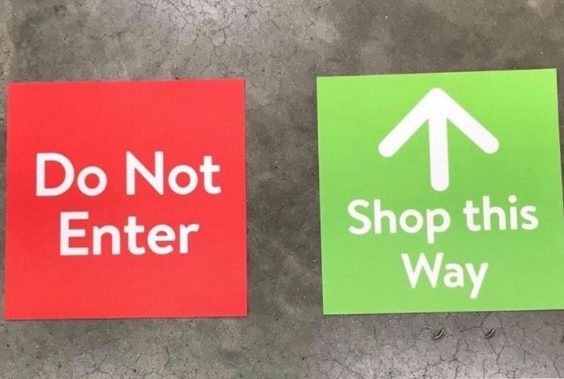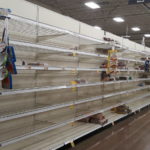You’ve probably seen and read about some of the confrontations taking place at stores, involving shoppers who refuse to wear masks. But it turns out, it’s those darned one-way aisles that really tick us off.
Grocery stores have implemented a number of changes during the coronavirus emergency to keep shoppers and staffers safe. Some of those changes may be temporary, others may be here to stay. But there are some in particular that shoppers are hoping will reach their expiration date sooner rather than later.
The management consulting firm McKinsey & Company recently surveyed shoppers about the safety measures stores have put in place. They asked shoppers what the most important safety criteria are, when deciding where to do their shopping – and what are the least important.
Unsurprisingly, shoppers want their stores to be clean. 92% said increased cleaning was a top priority. That was followed closely by availability of sanitizing supplies throughout the store, and improved air filtration.
Shoppers also want to make sure stores assist them in their efforts to keep their distance from others, and ensure that they don’t come into contact with those who are sick. Many stores have placed decals on the floors, six feet apart, indicating where shoppers should stand. And respondents to McKinsey’s survey appreciate that – 84% said customer distancing in lines was among the most important safety measures. That was followed by employee temperature screening to ensure that sick employees aren’t working, the installation of plastic barriers with cashiers, and a limit on the number of customers allowed inside at any one time.
Masks, which have become the most visible part of our new coronavirus reality, apparently aren’t as important to shoppers. 76% said customers and employees wearing masks was important to them, placing it in the middle of the pack of the most important criteria when choosing where to shop. Another commonplace change, instituting special shopping hours for high-risk shoppers like seniors or those with compromised immune systems, was cited by just 74%.
Curiously, given all the talk about online grocery shopping taking off during the pandemic, the availability of online shopping and digital checkout options isn’t so important to the shoppers in McKinsey’s survey. Bringing up the rear among the most important criteria, were cashierless checkout, cited by 65%, closely followed by curbside pickup, no-contact delivery and buy-online-pick-up-in-store.
While McKinsey agrees that more shoppers will probably stick with online grocery shopping once the crisis eases, the company believes most who have tried it are doing so only out of necessity, and that the majority of shoppers will return to in-person shopping. “Activities that are specific to the COVID-19 crisis, such as workarounds for largely in-person activities — including professional videoconferencing and curbside pickup — are less likely to stick around once the crisis passes,” McKinsey says.
And then there are those one-way aisles. Many stores have installed directional signs, to help shoppers progress through the aisles in an orderly fashion without passing each other while headed in opposite directions. But this safety measure finished dead last in McKinsey’s survey, with only 60% saying it was important to them, and only 2% saying it was the most important criterion of all.
“One-way aisles are designed to increase social distancing and give customers more space on each aisle,” Walmart explained when it began mandating them in all stores last month. But many shoppers aren’t sold on the idea. You might forget an item on an aisle you’ve already visited, and can feel like you’re having to go through a maze just to get back to where you were. Or you might get stuck behind someone who’s browsing and taking their time.
The one-way aisles “forced me to spend more time in the store and walk down many more aisles than necessary, exposing me to way more people than if the aisles were two-way,” one shopper wrote on Twitter. Comments like that prompted at least one grocery chain, Pennsylvania-based Giant, to give up and remove the directional signs from its stores.
But other stores are sticking with one-way aisles. And most commenters seem to resent following the rules when it seems so many others aren’t. “25% of people chose to ignore” the signs in her store, another Twitter user wrote. “When I pointed the signage out to one woman, she called me crazy and mean.” “Good luck to all those grocery stores out there with one-way aisles,” another commenter wrote. “We teachers have been trying to get people to walk in straight lines for years with very little success.”
Ultimately, no one can object to cleaner stores – so hopefully, that’s one change prompted by the coronavirus crisis that becomes permanent. And most people will likely continue keeping some distance from others in public, for some time to come. But signs telling you which way to walk in stores? “Someday we’ll be telling our great-grandchildren about 2020 and how grocery stores had one-way aisles!” one Twitter user wrote – an encouraging sign, perhaps, that not every change prompted by the coronavirus is here to stay.
Image source: Walmart

















The REAL problem with one-way aisles is when you get stuck with an old lard-ass in a scooter who needs 10 years to make up her mind what she wants and blocks the whole aisle. In that situation, forget the d@mn rules – I’m going to go around and come back up the wrong way whether anyone else likes it or not.
The problem with one-way aisles is lack of enforcement. At the one supermarket I shop at with one-way aisles, the vast majority of shoppers ignore the arrows, and no employees correct them People have no problem standing in a line to get in when there’s an employee at the door monitoring them, or waiting to be directed to an open checkout line. But I’m beginning to think the one-way aisles are just for stores to represent to state and local health authorities that they are adhering to requirements. If they really felt strongly that this could protect lives, they’d enforce the signs. But they don’t and people are wandering through the stores however they please.